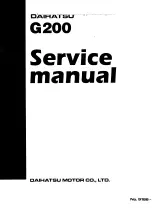
Tire change procedure
1. Park on a level surface, activate
hazard flashers and set the parking
brake.
•
Automatic transmission: Place
gearshift lever in P (Park).
•
Manual transmission: Place
gearshift lever in R (Reverse).
•
Electronic Shift-On-the-Fly
(ESOF) 4WD: Place transfer case
in any position.
•
Manual shift transfer case 4WD:
Place transfer case in 2H, 4H or 4L.
To help prevent the vehicle
from moving when you
change a tire, be sure the parking
brake is set, then block (in both
directions) the wheel that is
diagonally opposite (other side
and end of the vehicle) to the tire
being changed.
2. Turn engine off and block the diagonally opposite wheel (block not
provided).
3. Remove the jack, jack handle, lug wrench and spare tire from the
stowage locations.
4. Use the tip of the lug wrench to remove any wheel trim.
5. Loosen each wheel lug nut one-half turn counterclockwise but do not
remove them until the wheel is raised off the ground.
When one of the rear wheels is off the ground, the transmission
alone will not prevent the vehicle from moving or slipping off the
jack, even if the transmission is in P (Park) (automatic transmission)
or R (Reverse) (manual transmission). To prevent the vehicle from
moving when you change the tire, be sure that the parking brake is set
and the diagonally opposite wheel is blocked.
2006 F-250/350/450/550
(f23)
Owners Guide (post-2002-fmt)
USA
(fus)
Roadside Emergencies
220
















































